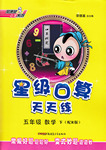题目内容
Dad: OK, kid, what' s so important 1. we have to meet in secret?
Daughter :Well, it' s about the 22nd of next month. I- d like to have 2. surprise party for Mum but I need your help. I thought that maybe you could take her to a movie, you know, just the two of you. Then while you' re away I can decorate the family room 3. invite lots of friends.
Dad.That 4. (sound) great but how do I manage to get her back without 5. (go) out to dinner after the movie?
Daughter: Oh, that' s easy. You just say that you want to pick me up in order to make it a family 6. ( celebrate). After the movie is 7. , you send Mum in to get me and when she comes in the front door everyone shouts "Happy birthday" to surprise her.
Dad: What about food? You don't have time to cook it 8. (you) , do you?
Daughter: I’ll order everything to be 9. (send) from the restaurant nearby while you are enjoying the movie.
Dad: I'm so happy you have handled this so 10. (beauty).
 星级口算天天练系列答案
星级口算天天练系列答案 芒果教辅达标测试卷系列答案
芒果教辅达标测试卷系列答案
